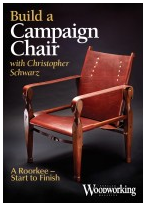We may receive a commission when you use our affiliate links. However, this does not impact our recommendations.
 I am building my first campaign chair with hard maple. Can you recommend a finish to make a darker look to the light color of the maple?
I am building my first campaign chair with hard maple. Can you recommend a finish to make a darker look to the light color of the maple?
Also, Christopher recommended ‘black wax’ in the video. Will that work on my maple and where can you buy black wax?
Ken
FWIW, I like the look of maple with a clear finish – why not let the beauty of the wood shine through (though it would give you a more modern look)? But if you want to make it darker, the simplest way – especially if you have a spray setup – is to use an aniline dye (but test it first on offcuts, of course); you can read about those here and here. If you don’t have a spray system, test some gel stains (I’ve had good luck with the ones from General Finishes) on offcuts until you get the look you’re going for – and gel stain has the benefit of reducing blotching. You can read what Bob Flexner has to say about gel stains (and wood conditioners) here.
The wax is “black bison wax” by Liberon and you can get it at Woodcraft, Rockler, Van Dyke’s, Amazon, etc. but I’m afraid it doesn’t work well on woods with closed grain such as maple (it works best on open pored woods such as oak and mahogany).
— Megan Fitzpatrick
Thanks for your suggestions. The reason I was hoping to have a darker wood color is because I plan to use the chair with my RV as we travel and it will be used virtually outside all of the time and I think that the darker color won’t show the dirt and wear marks that the lighter maple may show.
What say you?
Ken
Hmm…I think if I were using it outside all the time, I would use a water-resistant finish so I could wipe off the dirt…and because that will protect the wood better. So I guess no matter what stain, dye or finish you use, I’d topcoat with poly or a few coats of lacquer. (I have some dark-colored wood chairs on my patio, and they still show dirt, FWIW.)
But, if you like the look of the maple sans stain, maybe a varnish? So far I’m happy with the Formy’s Tung Oil Finish that I used on my wooden kitchen counters (yes, I could have made my own wiping varnish). It’s doing a good job of beading water and keeping other things (tomato sauce) from getting into the wood. It darkened my beech counters a little, and made them warmer looking (you can’t use it over another finish, according to the manufacturer, though…so no staining if you go that route).
And no matter what you use (poly, varnish or lacquer), keep an eye on the finish – if you see cracks or deep scratches, you’ll want to recoat for enduring protection. Once water gets below the finish, it’s the beginning of the end. (In fact, I might find some rubber sleeves at the home center that will fit the bottom of the legs…the ground is the most likely offender for water getting into the legs!)
—Megan Fitzpatrick
Here are some supplies and tools we find essential in our everyday work around the shop. We may receive a commission from sales referred by our links; however, we have carefully selected these products for their usefulness and quality.










Most Black Bison Wax is not black – read the label.
The term “poly” is a prefix used for many polymers and polymer formulations. It is a generic class identifier, not a specific material as you use it. Used alone, it is ambiguous and idefinite and definitely incomplete as guidance to others.
In coatings and finishes, it may be a part of “polyvinyl chloride” or “polyester” or “polyamide” or “polyepoxide” or “polyethylene oxide” or “polyurethane” and surely others. Use of the term “poly” is sadly common when only one of the many types of coatings, etc. is intended. One does, however, expect something better from a prominent magazine and its editor. Particularly a Shakespearean scholar. (While Shakespeare himself was a bit cavalier with the language at times and indulged in common vernacular, it doesn’t mean you should take license to do so.)
For outdoor furniture spar varnish is a good top coat. You can find it at some hardware stores and online, but a marine supplies store is your best bet. It is more expensive but I’ve found it to be about the best protection for wood that sits outside a lot and gets exposed to the elements.
Jim